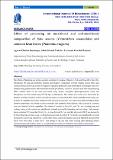| dc.description.abstract | The effects of blanching and drying on micro-nutrients: β-Carotene, Vitamin C, Folic acid, Iron (Fe), Zinc (Zn),
Phosphorus (P) and anti-nutrients: Tannins and Oxalates composition of False Sesame Leaves (FSL) and
Common Bean Leaves (CBL) were investigated. Vegetables preferences and preservation technologies used were
assessed using questionnaire. Micronutrients content: β-Carotene, Vitamin C, and folic acid were analyzed using
HPLC method while Fe, Zn were determined using Atomic Absorption Spectrophotometer (AAS) and
Phosphorus was determined using UV-VIS Spectrophotometer. The oxalate and tannin were determined by
titration and Folin Ciocalteu method. Several vegetables were identified, FSL (95.9%) and CBL (100%) being one
of them. In vegetable processing, boiling (76.9%) and sun drying (15%) were reported in Bahi and Mbeya Rural
Districts respectively. Sun drying was the commonly used method in both districts. Folic acid and β- Carotene
were not detected in both vegetables. The vitamin C content in fresh FSL and CBL was 16.28mg/100g and
5.48mg/ 100g, yet the content was significantly reduced (p<0.05) by blanching and sun drying. False sesame
leaves contained P (700mg/kg), Fe (115.75 ± 2.23mg/kg) and Zn (14.13mg/kg) whereas in CBL P was 600mg/kg
Fe (652.76mg/kg) and Zn (41.04 ± 0.28mg/kg) respectively. Levels of P, Fe and Zn were significantly (p<0.05)
increased by sun drying respectively. On the other hand, tannin and oxalate content in blanched and sun dried
leaves were lower than in fresh leaves. Sun drying of FSL and CBL while covering after blanching further
reduces tannins and oxalates, thus it is recommended as an effective method in anti-nutrients elimination. | en_US |

